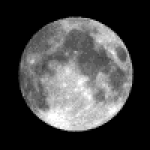Freedom 7 II (1/32)
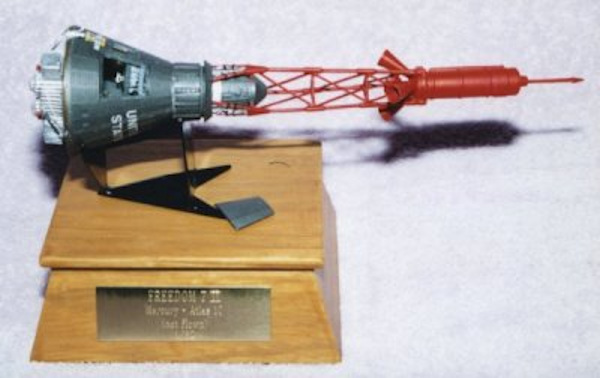
This is a model of a Mercury spacecraft that is flightworthy, but was never flown. After the day and a half mission of Gordon Cooper in Faith 7 in May 1963, some consideration was given to flying a three-day mission with the Mercury spacecraft adapted to hold the additional consumables required (e.g. water, oxygen, fuel, batteries, etc.). This was eventually decided against and the Mercury Program was officially closed so that NASA could move more expeditiously onto the Gemini two man space program. But in the meantime, a spacecraft was prepared for the mission, and the name its pilot had given it was painted on the side (as was the tradition in the Mercury days), "Freedom 7 II". The pilot was to be Alan Shepard, the first American in space, who made a 15 minute sub-orbital flight in Freedom 7 on May 5th, 1961, and in honour of his earlier spacecraft he named this one "Freedom 7 II". To hear Alan Shepard give a brief history of plans for this flight, click here.
In the summer of 1996 I saw this spacecraft in the visitor's centre museum at the Ames Research Center in the bay area of California (it has since been moved from there), which was my inspiration for making this model. The model is based on the Collectaire resin kit, modified with the containers for additional consumables on the rear, much interior detailing and a light in the cabin.
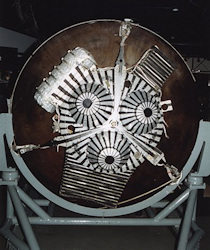 Rear of the real
Freedom 7II (click to enlarge)
Rear of the real
Freedom 7II (click to enlarge)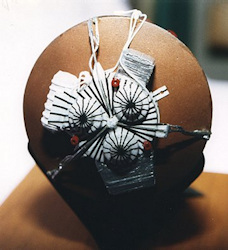 Rear of the Freedom 7 II model
(click to enlarge)
Rear of the Freedom 7 II model
(click to enlarge)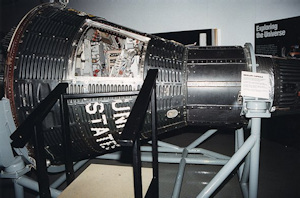 Side of the real
Freedom 7II (click to enlarge)
Side of the real
Freedom 7II (click to enlarge)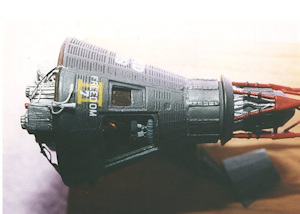 Model of
Freedom 7II (click to enlarge)
Model of
Freedom 7II (click to enlarge)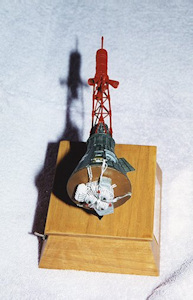 Model of
Freedom 7II (click to enlarge)
Model of
Freedom 7II (click to enlarge)Voskhod 2 (1/25)
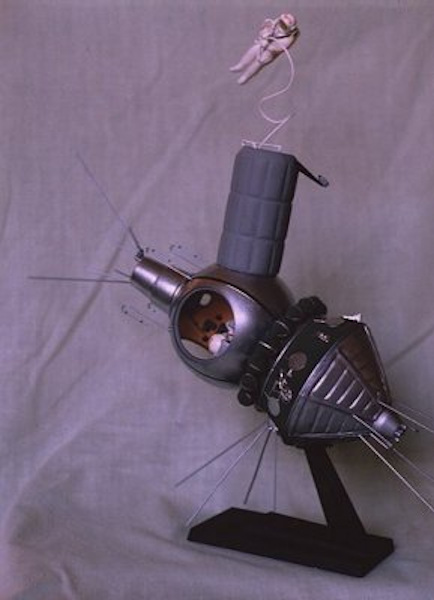
The world's first spacewalk took place on March 18th, 1965 during the flight of Voskhod 2 when Cosmonaut Alexei Leonov entered an inflatable airlock attached to the side of the spacecraft and then minutes later exited into the empty void.
The Voskhod spacecraft was actually a modified Vostok with safety features such as the ejection seat removed to accommodate more than Vostok's one man. At the time the configuration of the Voskhod was not known in the West. It was assumed that, once again, the Soviet Union had left the United States in its dust in the "Space Race", as had Voskhod 1 five months earlier when for the first time three men orbited in one spacecraft.
In retrospect, Voskhod 2 can be seen as the last of the great Soviet manned space spectaculars. The American Gemini program, the first manned flight of which (Gemini III) was launched less than a week after Voskhod 2, would equal and eventually surpass most Soviet-held manned spaceflight records before its two years of manned flights ended in late 1966. At the time of Leonov's spacewalk the plans for an "extra-vehicular activity" (or "EVA") in the Gemini program were still many months away. In the wake of Leonov's feat the US expedited its plans for EVA in Gemini and Edward H. White performed the first American spacewalk on only the second Gemini flight, Gemini IV, in June 1965.
This model is based on the East German Plasticart 1/25 Vostok kit which was available in the 1970s and 1980s. The Alexei Leonov figure is based on a 1/25th figure of General George Patton, with extensive modifications.
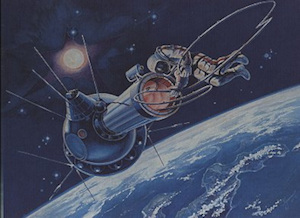 Alexei Leonov's own painting of himself making the world's first spacewalk
(click to enlarge)
Alexei Leonov's own painting of himself making the world's first spacewalk
(click to enlarge)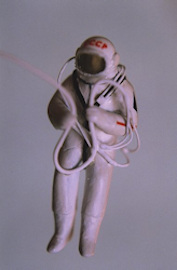 detail of Voskhod 2 model figure spacewalking (click to enlarge)
detail of Voskhod 2 model figure spacewalking (click to enlarge)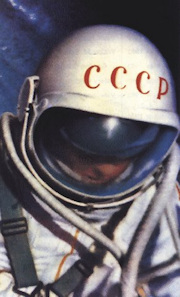 closeup of the real Alexei Leonov during the world's first spacewalk
(click to enlarge)
closeup of the real Alexei Leonov during the world's first spacewalk
(click to enlarge)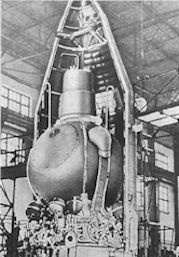 Voskhod spacecraft being prepare for flight in the 1960s
(click to enlarge)
Voskhod spacecraft being prepare for flight in the 1960s
(click to enlarge)Gemini-Titan II (1/100 and 1/48)
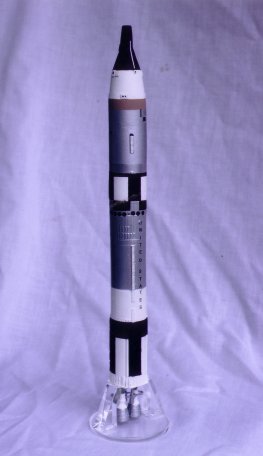
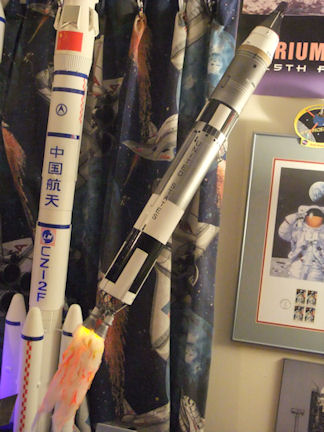
The Titan II was a second generation American ICBM. The Atlas, the first American ICBM, burned a mixture of kerosene and liquid oxygen. Readying the Atlas for launch was difficult and required several hours advance notice. Handling the super cold liquid oxygen was especially problematic as it would quickly boil off and thus had to be loaded immediately before launch. This was obviously not optimal for a strategic weapon, and so very quickly on the heals of the development of the Atlas efforts began to develop an ICBM which could be prepared for launch more quickly. Thus by the late 1950s development of the Titan II, which used propellants which could be stored in the rocket for long periods of time at room temperature without difficulty, was well underway. The Titan II's propellants were "hypergolic", meaning they burned on contact requiring no ignition source.
As a strategic weapon system the Titan II was a considerable improvement on the Atlas, and was in use for many years subsequently. Titan IIs were stored in underground silos, hardened against nuclear attacks, at a number of locations around the US. The Titan II was larger with a greater lift capacity than the Atlas as well, and thus was used as the booster for the second generation American manned spacecraft, the two-man Gemini spacecraft, which flew in 10 manned missions in 1965 and 1966.
Eventually the Titan IIs were replaced in the underground silos around America with ICBMs which required even less preparation time before launch, the solid fueled ICBMs like the Minuteman (click for photo of a Minuteman at Vanderberg AFB) and Peacemaker. However, as a launch vehicle, the Titan in its various configurations continued to serve for many years, not being retired finally until the new millenium.
There are two models of the Gemini-Titan II in the Shrine. The first, which I built in the late 1980s, is 1/100 scale and entirely scratchbuilt, although the Titan II is a cast made from a mold taken off the core stage of the then unavailable MPC 1/100 Titan III C kit. The second, built in 2012, is in the much larger 1/48 scale and is from the Eagle's Talon "garage" kit which was available in the 1990s. By their nature such kits require a lot of additional detailing work to produce a good looking final result. I am particularly pleased with the metallic finish on this model, featuring two differing tints of aluminum, dull and polished, using airbrushed Alclad lacquer paint. The markings on this Titan are for Gemini 3, the "Molly Brown" with Gus Grissom and John Young, the first manned Gemini mission on March 23rd, 1965. This 1/48 Gemini-Titan is hung from the ceiling in the Shrine. In its two first stage engines are mounted bulbs taken from LED "tea lights" which flicker and are surrounded by cotton batting smoke highlighted with glow in the dark orange paint - this to simulate smoke and flame under the darked UV flooded night lighting in the Shrine (see photo below).
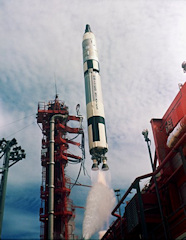 Gemini-Titan 11 Launch, september 12th, 1966 (click to enlarge)
Gemini-Titan 11 Launch, september 12th, 1966 (click to enlarge)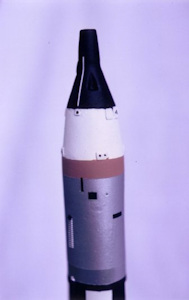 Gemini-Titan 1/100 model detail (click to enlarge)
Gemini-Titan 1/100 model detail (click to enlarge)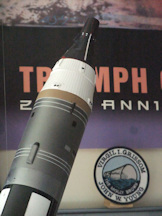 Gemini-Titan 1/48 model detail (click to enlarge)
Gemini-Titan 1/48 model detail (click to enlarge) Gemini-Titan 1/48 model with engines lit and night lighting (click to enlarge)
Gemini-Titan 1/48 model with engines lit and night lighting (click to enlarge)Gemini-Agena 11 (1/48) & Gemini-Agena 9 (as it should have been) (1/24)
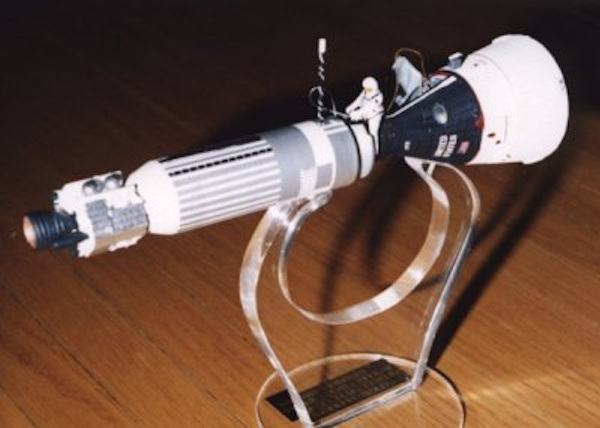
The American two-man Gemini Program was conceived, after the moon landing had been established as a goal, to bridge the gap between the early one-man Mercury missions and the far more sophisticated Apollo missions yet to come. The major purpose of the Gemini missions was to practice techniques that would be required for flights to the moon, including rendezvous and docking of two spacecraft, extra vehicular activity ("EVA" or "spacewalking") and long duration manned spaceflight.
The Gemini 11 model depicts the Gemini spacecraft docked with an Agena target vehicle with Astronaut Richard F. Gordon straddling the Agena as he attaches a tether between the two spacecraft for an upcoming experiment, based on a well known photo taken during the mission on September 13th, 1966 (see below). By firing this Agena's engine while docked to it, Gemini 11 was boosted to a height of 850 miles above the Earth, a record for manned spaceflight that stood for several years (until Apollo 8 took the first men to orbit the moon in December 1968).
The Gemini 11 model is based on Revell's 1/48 kit with extensive additional detailing. The Agena docking target is entirely scratchbuilt.
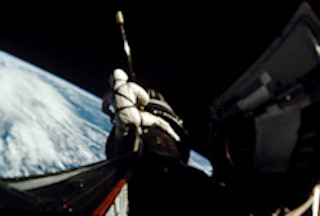 Gemini-Agena XI with Richard F. Gordon spacewalking, Sept. 13, 1966
(click to enlarge)
Gemini-Agena XI with Richard F. Gordon spacewalking, Sept. 13, 1966
(click to enlarge)
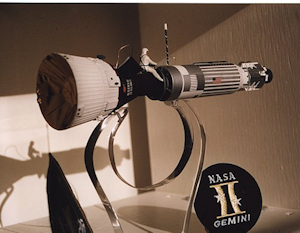 Gemini-Agena XI model with Richard F. Gordon spacewalking (click to enlarge)
Gemini-Agena XI model with Richard F. Gordon spacewalking (click to enlarge)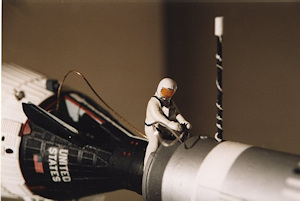 Detail of
Gemini-Agena XI model (click to enlarge)
Detail of
Gemini-Agena XI model (click to enlarge)Almost 30 years after building the Gemini 11 model, I wanted to build a larger, more accurate and detailed Gemini-Agena model. So as to be able to depict both the Agena and the Astronaut Manuevering Unit (AMU), I call this model "Gemini 9 as it should have been", as it depicts the original plan for Gemini 9, not what actually happened on the flight.
Briefly, Gemini 9's original Agena target vehicle failed to reach orbit upon launch. Lacking another Agena target readily available and to expedite the mission, a less capable substitute target vehicle which was available, the Augmented Target Docking Adapter (ATDA), was launched a week or so later. While this docking target did reach orbit, its nose fairing failed to properly separate making it impossible for the Gemini to dock. The ATDA was famously dubbed "the angry alligator" by Command Pilot Tom Stafford, for its still attached and partially opened fairing looked like the jaws of an alligator.
Gemini 9 was the only mission on which the Astronaut Manuevering Unit (AMU) was carried. This was a "jet backpack" that facilitated untethered flight by one astronaut. It was housed in the rear of Gemini's Equipment Adapter section, which Gemini 9 Pilot Gene Cernan was supposed to strap on his back and fly autonomously near the spacecraft. In actual fact Cernan's Extra Vehicular Activity (EVA or "spacewalk") was a disaster, as he flailed about helplessly with almost nothing to hold on to, unable to control his movements to perform the planned work. This was only the second America spacewalk, and here it became apparent that it was not as easy as had been presumed. Cernan was soon exhausted and the use of the AMU was accordingly cancelled. I am impressed with the risk that was accepted in these early days of manned spaceflight: maneuvering the AMU was powered by hydrogen peroxide thrusters, and thus hot gases could impinge on Cernan's pants. As a result, steel threads were woven into the pantlegs of Cernan's spacesuit!
The Gemini 9 "as it should have been" model is based on Revell's larger 1/24 Gemini kit with extensive modifications, and Real Space Models' 1/24 Agena target vehicle kit. The EVA astronaut is modified from the Astronaut Ed White figure in the Czech firm New Ware's "First Spacewalkers" kit and AMU is entirely scratchbuilt. The Gemini-Agena and the Astronaut-AMU are hung from the ceiling in the Shrine.



Saturn I, Block 2 (1/144)

The Saturn family of boosters were developed by Wernher von Braun's group at the Marshall Spaceflight Center in Huntsville, Alabama in the late 1950s and 1960s. The Saturn concept was to "cluster" tanks, engines and other components from smaller rockets to provide heavy lift boost capability. The Saturn I was the first of the series, with the model here depicting the "Block 2" version of this booster. This was the first of the Saturn family to use high powered hydrogen/oxygen fuels in the second stage (the S-IV stage), which was a pattern carried forth in all subsequent Saturns (i.e. the Saturn IB and the Saturn V "moon rocket"). All Saturn Is were launched unmanned.
This model is based on the Airfix Saturn IB kit, with new fins on the first
stage and extensive modifications to depict the upper stage and the boilerplate
Apollo spacecraft.
 Saturn-Apollo 7 (SA-7)launch, September 18th, 1964 (click to enlarge)
Saturn-Apollo 7 (SA-7)launch, September 18th, 1964 (click to enlarge)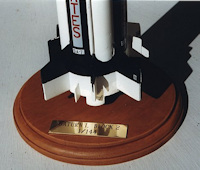 Detail of Saturn I, Block 2 model (SA-7) (click to enlarge)
Detail of Saturn I, Block 2 model (SA-7) (click to enlarge)Saturn C-8 "NOVA" (1/144)

The Saturn C-8 booster was never built, but was a design/paper exercise in 1961-62 when consideration was being given to which method would be best to achieve President John F. Kennedy's goal of "before this decade is out, landing a man on the Moon and returning him safely to the Earth". At that time there were three (3) methods under consideration: Direct Ascent, Earth Orbit Rendezvous, and Lunar Orbit Rendezvous. Initially Direct Ascent was considered best because rendezvous of two vehicles in orbit (that is, two vehicles meeting & joining while in orbit, which is essentially a continual state of free-fall) seemed like such a daunting task. While joining two vehicles in Earth orbit seemed bad enough, doing it at Lunar distances while in orbit around the Moon seemed even worse. Direct Ascent required that the entire spacecraft, including the heavy heat shield which would be required to re-enter the Earth's atmosphere at the end of the mission, first land and then take off again from the surface of the Moon. The Saturn C-8, sometimes known as the "NOVA" was conceived to facilitate a direct launch from Earth to a landing on the Moon, and thus had to be considerably bigger and more powerful than the Saturn V (then the "Saturn C-5") which was eventually selected along with the Lunar Orbit Rendezvous method.
The Saturn C-8 had four stages, including the top stage required to lift off from the Lunar surface. The first stage boasted eight F-1 engines (the Saturn V had five F-1s in its first stage) burning kerosene and liquid oxygen, while the second stage had eight J-2 engines (the Saturn V had five J-2s in its second stage) burning the more powerful liquid hydrogen & liquid oxygen combination. Two J-2 engines were to be used in the Saturn C-8's third stage (the Saturn V's third stage had only one J-2 engine). However, the Saturn C-8 was not as much taller than the Saturn V as might be anticipated because the Vehicle Assembly Building (VAB), in which either vehicle would be put together, was aleady designed and moving towards construction. Given the height limitation of the VAB, the first stage fuel tanks of the Saturn C-8 had to be squeezed down, and as a result the eight F-1 engines were arranged in a circle around the fuel tank.
There were other problems with the Direct Ascent method to land on the Moon. For example, no one was clear on how the astronauts would be able to see their landing site when backing the spacecraft down onto the Lunar surface, as windows in the Apollo Command Module would face forward / up. And when this large spacecraft landed the astronauts would be a considerable height above the surface, requiring a dangerous long climb down. In the end, Lunar Orbit Rendezvous was selected as the method to put a man on the Moon since it would require only one Saturn V for the mission (Earth orbit rendezvous would require several Saturn Vs), but that meant that rendevous techniques had to first be perfected. This then became a major goal of the Gemini program, which preceded the Apollo manned Moon landing program.
This model is built from a resin kit from one of the small "garage" space model kit manufacturers, Martin's Models in the UK.
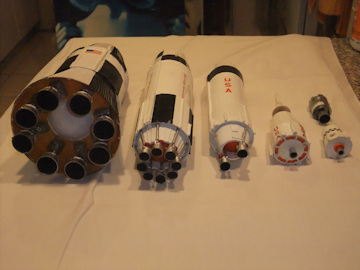 Saturn C-8 model stages (click to enlarge)
Saturn C-8 model stages (click to enlarge)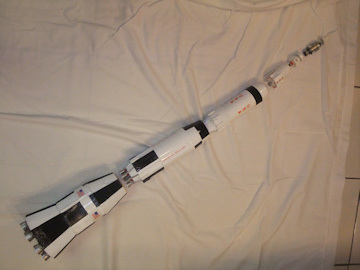 Saturn C-8 model stages lined up (click to enlarge)
Saturn C-8 model stages lined up (click to enlarge)Skylab (1/96)
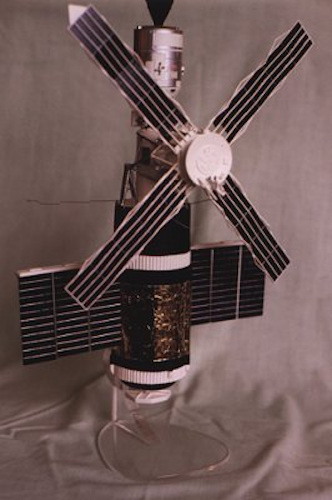
Skylab was America's first manned space station. The Skylab Program, initially called the "Apollo Applications Program", used hardware originally developed for the Apollo moon landing program to place a manned scientific station in Earth orbit for extended spaceflight. Skylab 1 was launched unmanned on May 14th, 1973 using a modified Saturn V, (click for photo of model of the Skykab Saturn V) the rocket originally developed to take men to the moon. Three 3-man teams were launched on the smaller Saturn IB rocket in an Apollo Command/Service Module (CSM) spacecraft over the coming months in 1973 and 1974 to dock with Skylab 1 and occupy the station for periods of up to 81 days.
The large cylindrical part of this model, the "Orbital Workshop", is based on the S-IVB third stage of the Revell Saturn V kit much as was the real Skylab Orbital Workshop. The CSM is also from the Revell kit. The remainder of the model, the "Apollo Telescope Mount", "Multiple Docking Adapter", solar panels, strut work and so on is all scratchbuilt.
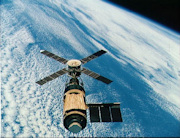 Skylab in orbit, February 8th, 1974 (click to enlarge)
Skylab in orbit, February 8th, 1974 (click to enlarge)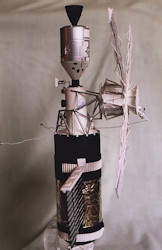 Skylab model (click to enlarge)
Skylab model (click to enlarge)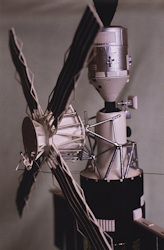 detail of Skylab model (click to enlarge)
detail of Skylab model (click to enlarge)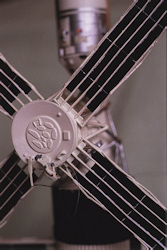 detail of Skylab model (click to enlarge)
detail of Skylab model (click to enlarge)Australia's First Satellites (1/48)

I was inspired to build models of the launch vehicles for Australia's first two satellites after attending the International Astronautical Congress (IAC) in Adelaide Australia, with a side trip to the Woomera Test Range (click for more on this on page 2) in the Australian desert, in September 2017. In particular, it was then that I came to better appreciate the significant role that my good friend Richard Tonkin played in the spaceflight history of that nation.
Briefly, the story is that in the mid-60s (around 1965) a group of University of Melbourne students who had an interest in spaceflight, inspired by Sputnik and the early conquests of space, came together and decided that they would like to build a satellite. They contacted the organization overseeing the OSCAR satellites (Orbiting Satellite Carrying Amateur Radio) which indicated that, if the students built such a satellite, they would attempt to get it launched on an American rocket. So for the next couple of years the students worked on building the satellite. It was a small satellite (click for photo of Australis OSCAR 5) about the size of a brief case that could be launched as a secondary payload with a larger satellite as the primary payload, and in June 1967 it was completed and sent to America accompanied by several of the student group (Richard included). At that point they expected the satellite to be launched soon thereafter, but for whatever reason that did not happen, and the satellite went into storage in the USA for several years.
Meanwhile at the Woomera Test Range in the Australian desert, a joint United States-United Kingdom-Australian research program aimed at understanding re-entry phenomena called Sparta was underway. The Sparta rocket used a surplus American Redstone as its first stage, an Antares-2 as a second stage, and a BE-3 as a third stage. Several Spartas were launched in 1966-67 from Woomera. Once the program had achieved its goals there remained one spare Sparta rocket, which was then offered to Australia should it wish to launch a satellite. This idea was initially not received with a great deal of enthusiasm by the Australian government.
This is where the story gets particularly interesting. There had been a lot of press in Australia at the time (circa 1966 and early 1967) about this group of university students who had built Australia's first satellite, and had now shipped it off to the USA anticipating that it would be launched shortly. Upon returning from the USA after delivering the satellite one of the students in the group, Owen Mace, received a mysterious phone call from someone in the Australian government, inquiring about when the students' satellite would be launched, etc. The very next day the Australian government announced it would be putting Australia's first satellite into orbit on that surplus Sparta rocket shortly. That satellite, named WRESAT (abbreviation for Weapons Research Establishment Satellite), was launched from Woomera (click for photo of WRESAT launch) on November 29th, 1967. It is speculated that the students who built Australis OSCAR 5 had embarrassed the Australian government into action. The students' satellite, Australis-OSCAR 5, was finally launched on a Delta N-6 (designated Delta 76) (click for NASA Goddard news coverage) rocket from Vandenberg Air Force Base in California on January 23rd, 1970. Thus the university students' satellite was the first to be built in Australia, but the second Australian satellite to be launched into orbit.
The fascinating story of Australis OSCAR 5 has been the subject of a book written by Owen Mace and an excellent 15 minute documentary, both of which can be accessed through links on the Australis OSCAR 5 website (link to Australis OSCAR 5 website). The University of Melbourne is understandably proud of their involvement in this story as well, and have a webpage (link to University of Melbourne webpage) dedicated to it.
Fortunately there were available two model kits in the same scale (1/48) that would form the basis for models of these two historic launch vehicles. The Delta N-6 model is based on the French company MACH 2's 1/48 scale Delta E (click for photo of Delta E box) model kit. As the Delta N-6 is considerably taller than the Delta E, and has 6 strap-on Castor booster rockets as opposed to the Delta E's 3 Castors, two of the MACH 2 kits were required to make a Delta N-6 from a Delta E (click for Delta E vs. Delta N-6 comparison) . The WRESAT launch vehicle is based upon Glencoe's 1/48 Jupiter C (click for photo of Jupiter C box) model kit with scratchbuilt upper stages (click for photo of conversion). Homemade decals of the iconic logos were made for both models.
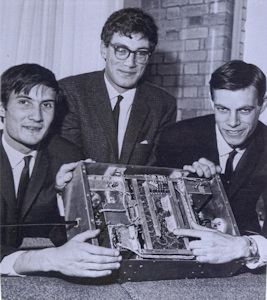 Owen Mace, Richard Tonkin and Paul Dunn with Australis OSCAR 5 (circa 1967) (click to enlarge)
Owen Mace, Richard Tonkin and Paul Dunn with Australis OSCAR 5 (circa 1967) (click to enlarge) Delta 76 on pad at Vandenberg AFB (click to enlarge)
Delta 76 on pad at Vandenberg AFB (click to enlarge)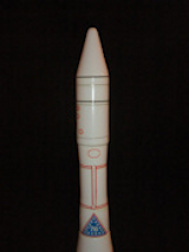 detail of Delta 76 model (click to enlarge)
detail of Delta 76 model (click to enlarge) detail of WRESAT/Sparta model (click to enlarge)
detail of WRESAT/Sparta model (click to enlarge)Click here to continue on to the fifth or sixth pages with more of my models of spacecraft and launch vehicles and the history behind them. To return to the models on the third page, click here. To return to the descriptions of my trips to space centres around the world, return to the home page or the second page.
This page will change and evolve over time, so check back periodically. I welcome any questions or comments and can be contacted at:
Ken R. Harman last revision date: January 2021